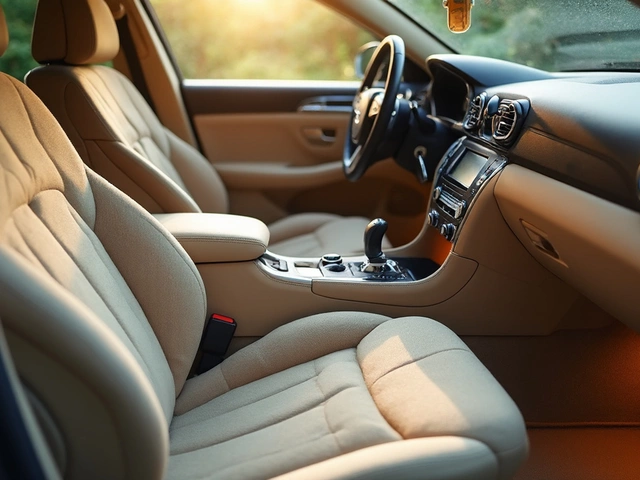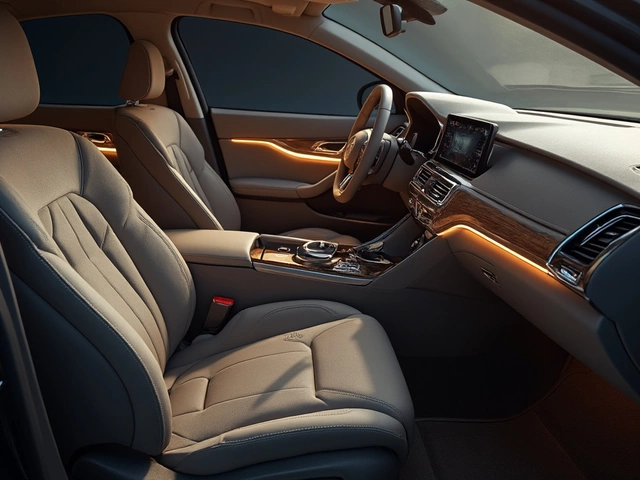When it comes to keeping your car's interior clean, Clorox wipes seem like a convenient option. After all, they promise to eliminate germs and stains with a quick swipe. But are they really safe to use on the delicate surfaces inside your vehicle?
The answer isn't as straightforward as it might seem. Different materials found in cars, like leather, vinyl, and plastic, might react differently to the chemicals in these wipes. It's important to understand what these wipes are made of and how they could potentially affect the surfaces in your car.
In this guide, we'll delve into what you need to know about using Clorox wipes for your car's interior. From safety tips to suitable alternatives, we'll cover it all so you can make an informed decision on how to best maintain your vehicle's cleanliness and look.
- The Composition of Clorox Wipes
- Safety Concerns for Different Car Materials
- Best Practices for Using Clorox Wipes
- Alternative Cleaning Solutions
The Composition of Clorox Wipes
Clorox wipes have become a household staple, especially during times when cleanliness and disinfection are at the forefront of people's minds. But just what goes into these wipes that makes them such a powerful cleaning tool? At their core, Clorox wipes are comprised of a unique mixture of chemicals specifically designed to tackle a broad spectrum of pathogens and dirt. The active ingredient in these wipes is a solution of sodium hypochlorite, which is effective against a variety of bacteria, viruses, and fungi. This chemical composition allows for quick and efficient cleaning by breaking down cell walls of microbes and effectively neutralizing them.
It's essential to note that besides the active ingredient, Clorox wipes also contain solvents like isopropyl alcohol. This component aids in evaporating quickly, ensuring surfaces dry without streaks or residue. Additionally, the wipes are impregnated with surfactants which help to lift dirt from surfaces. These surfactants are akin to those found in detergents, working to emulsify grease and grime. The fabric of the wipe itself is made from non-woven fibers that are robust enough to scrub away dirt yet gentle enough to prevent damage to most surfaces, making them a versatile cleaning product. Clorox wipes have also been infused with scents, often derived from lemon or other citrus, leaving a fresh aroma post-cleanup.
Understanding the composition of Clorox wipes brings up an important consideration: some chemicals can be harsh on certain surfaces or materials found in a car's interior, such as leather or certain plastics. Car interior elements are not uniform, and treating them with a blanket approach of chemical agents might lead to degradation over time. According to a study by the American Cleaning Institute, while these wipes are designed for general use, specific applications like automotive interiors require careful attention to what materials they are made of.
"Before applying any cleaning products, it's essential to test a small, hidden area," suggests automotive detailer Mark Arison. This highlights the necessity of caution when dealing with chemically-treated wipes.
Interestingly, the efficacy of these chemicals in ensuring a sanitized environment cannot be understated, yet users must balance the potential drawbacks of regular exposure of interior fabrics and surfaces to them. Those who opt to use Clorox wipes on their car interiors should be mindful of the frequency and ensure proper ventilation. Considering wipes have been around for quite some time largely unchanged in their core formula, it's worth acknowledging the complex interplay of their effectiveness and the importance of material compatibility in protecting your investment – your vehicle.

Safety Concerns for Different Car Materials
Using Clorox wipes on your car's interior may seem like an easy way to combat germs and dirt, but the reality is a bit more nuanced, particularly when you consider the variety of materials found in a vehicle. These wipes contain chemicals like sodium hypochlorite, which can be harsh on surfaces over time. The most common materials you'll encounter in a car interior include leather, vinyl, plastic, and fabric, each reacting differently to such cleaning products.
Leather interiors, for example, provide luxury and comfort, but they require careful maintenance to keep them in top condition. Clorox wipes, while excellent at disinfecting, can strip away the natural oils present in leather, leading to cracks and a dull appearance. This is because leather is porous, which means it absorbs the cleaning solution quickly. Over time, repeated exposure can dry out and damage the material, resulting in costly repairs or even replacements. It's often recommended to use specially formulated leather cleaners that nourish the upholstery rather than compromise it.
Vinyl and plastic surfaces might appear more resilient, but they are not immune to the potential drawbacks of using chemical wipes. Clorox wipes can cause the material to become brittle if used excessively. This is especially true in older cars, where the protective coatings might be worn off. The negative effects might not be immediate, but prolonged use can lead to discoloration or a sticky residue that attracts more dust and dirt. If you're considering using disinfecting wipes on such surfaces, it's crucial to limit exposure to just light cleaning and immediate wiping with a damp cloth to remove any residual chemicals.
Fabric seats and carpets pose another challenge entirely. The liquid content in Clorox wipes can seep into fabrics, causing them to become damp, which is not ideal in confined environments like car interiors where moisture can lead to mold and mildew. Stains might also become embedded deeper into the fibers, making them harder to remove later on. A good practice involves incorporating dry cleaning methods or specific upholstery cleaners that are designed to remove dirt while keeping moisture levels in check. As Paul Johnston, an automotive maintenance expert notes,
"Choosing the right product for your car interior is akin to choosing the right medicine for your body—it makes all the difference in preserving its value and condition over time."
Overall, while Clorox wipes might offer convenience and are effective disinfectants, it's essential to recognize their potential long-term impact on different car materials. Regular cleaning with these wipes might seem like a good practice but can actually lead to deterioration of surfaces, impacting the appearance and resale value of your vehicle. For those committed to preserving their car's interior, the best approach often involves understanding the specific needs of each material and opting for products that are designed to enhance rather than harm.

Best Practices for Using Clorox Wipes
Using Clorox wipes inside your car can be quite handy, but doing it right is crucial to avoid any unintended damage. Since these wipes are designed to eliminate germs, they contain chemicals that might not be suitable for every surface in your vehicle. Therefore, understanding the best practices can go a long way in ensuring your car remains in top-notch condition. First, you should know what material your car's interior is predominantly made of, such as leather, vinyl, or plastic, and how it might react to these wipes. It's always prudent to spot-test a small, hidden area before wiping down a larger visible surface. This simple step can save you from potential discoloration or damage.
One of the essential practices is to use the wipes gently. Over-scrubbing can cause more harm than good by wearing down the material's finish. When cleaning surfaces like the dashboard or steering wheel where dirt and grime commonly build up, ease into it with less pressure and let the moisture from the wipes do most of the work. Another good tip is to always follow up with a dry microfiber cloth. This helps to remove any excess moisture and prevents streaks, especially on glossy or transparent surfaces like touchscreens. Leather, being a luxurious material found in many modern cars, requires extra care. After using a Clorox wipe, it’s beneficial to apply a conditioner to keep the leather supple and prevent it from drying out.
It's important to note that Clorox wipes are disinfectants, not detailing agents. They should be used primarily for killing germs, and not for routine cleaning, which requires products specifically formulated for car interiors. For instance, a mild detergent diluted with water can be more appropriate for removing dirt, while the wipes can be reserved for sanitizing high-touch areas, especially during flu season or when illness has been a concern.
An expert from the automobile detailing industry often says, "Your car's interior is its sanctuary. Treat every material like skin—what keeps it healthy is what keeps it looking its best."This underscores the importance of gentle care and proper maintenance products. Lastly, keep your wipes in an accessible place but ensure they are not exposed to extreme temperatures. High heat can dry them out, rendering them ineffective.
By practicing restraint in both the frequency and force of wiping, you can protect your car's interior while keeping it clean and sanitized. A little bit of knowledge goes a long way in car maintenance, and by following these best practices, you can extend the life and luster of your vehicle's interior. Remember that knowledge empowers you to make the best decisions for your car's health.

Alternative Cleaning Solutions
Considering the significance of maintaining your car's interior without causing damage, exploring alternative cleaning solutions is a wise choice. While Clorox wipes may offer a quick fix, reputable car care experts suggest several other methods that are both effective and gentle on surfaces like leather, vinyl, and plastic. Notably, using products specifically designed for automotive interiors can often give you better results and longer-lasting protection. These alternatives ensure that your vehicle not only remains clean but also preserves its material integrity over time.
Among the numerous options available, creating a DIY cleaning solution with common household ingredients can be an efficient way to keep your car spotless. Mixing a mild soap with water creates a gentle cleanser suitable for most surfaces. For added shine and protection, a homemade vinegar-based solution is a popular choice for glass and dashboard surfaces. Simply blend equal parts of water and white vinegar, which effectively tackles smudges and provides a streak-free finish. It's simple, cost-effective, and safe for most car materials.
In terms of commercial products, dedicated car wipes and sprays are made to cater specifically to the unique needs of vehicle interiors. Products from brands like Meguiar's and Armor All are formulated to clean without leaving residues or dulling finishes. These products often contain ingredients that protect against UV damage, an essential feature considering the Australian sun. Investing in these specialized products might seem pricier upfront, but the benefits of long-term upkeep and protection of your car's interior could potentially save costs down the line.
Martha Stewart once said, "Your car is like a second home; treat it as such." This highlights the importance of using the right products just as we would for our home environments.
For those seeking eco-friendlier options, there are also biodegradable and non-toxic products available. Brands like Eco Touch and Mother’s offer environmentally conscious choices that promise great results without harsh chemicals. These products are not only healthier for people and pets but also contribute positively to reducing environmental impact. They usually employ plant-based ingredients while providing effectiveness comparable to conventional products.
To enhance your cleaning routine further, accessories like microfiber cloths are essential allies. Unlike regular rags or paper towels, microfiber materials lift dust and grime more effectively, preventing scratches and preserving the lustrous appearance of surfaces. Additionally, regularly using a vacuum with attachments can help keep fabric and carpeted areas free from dirt buildup, maintaining your car's overall neatness and appeal.




